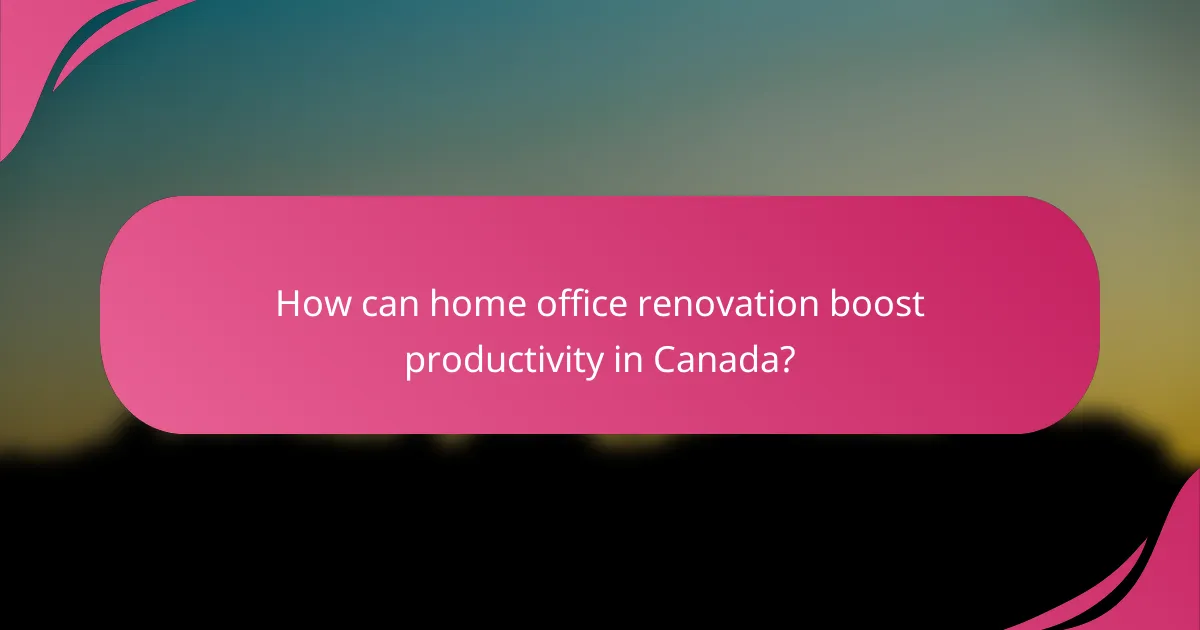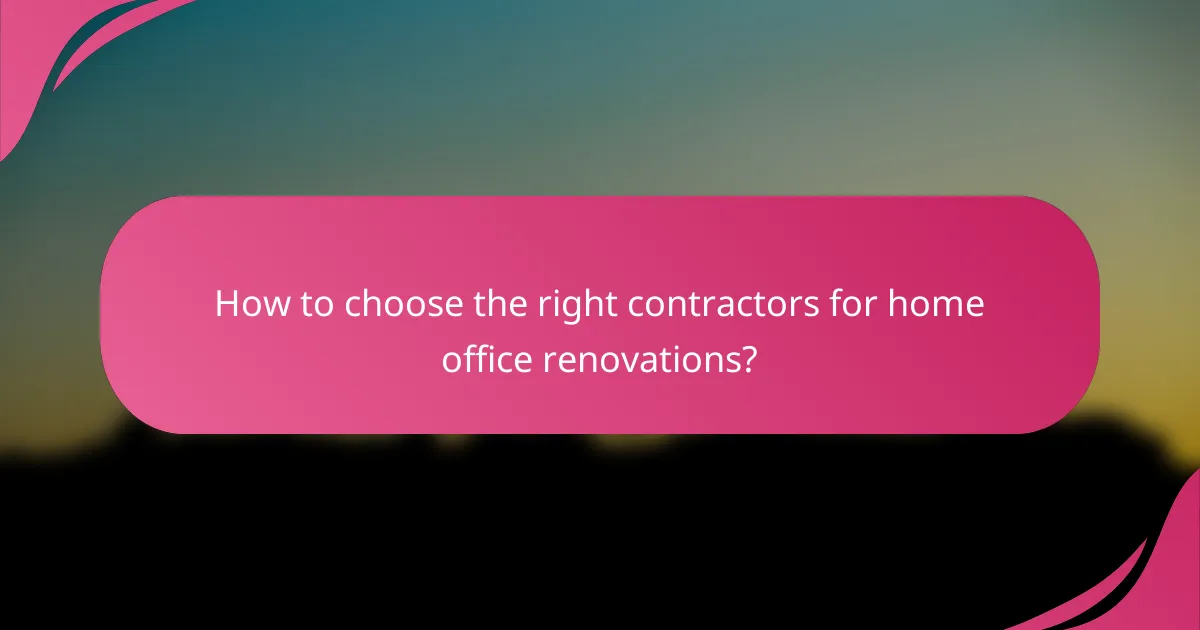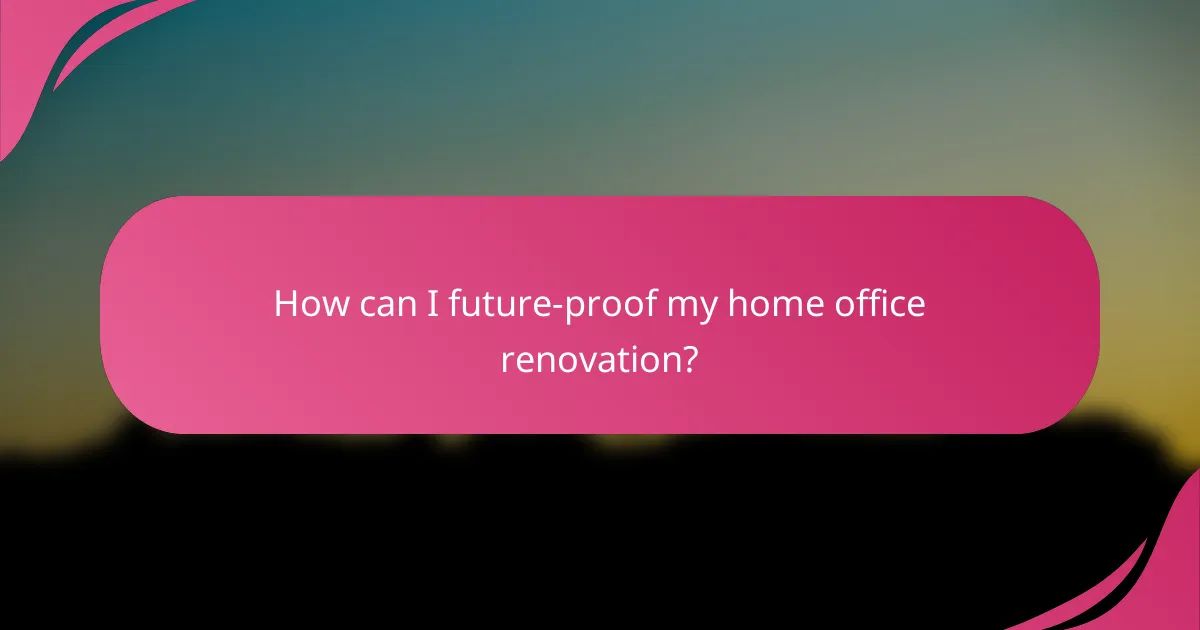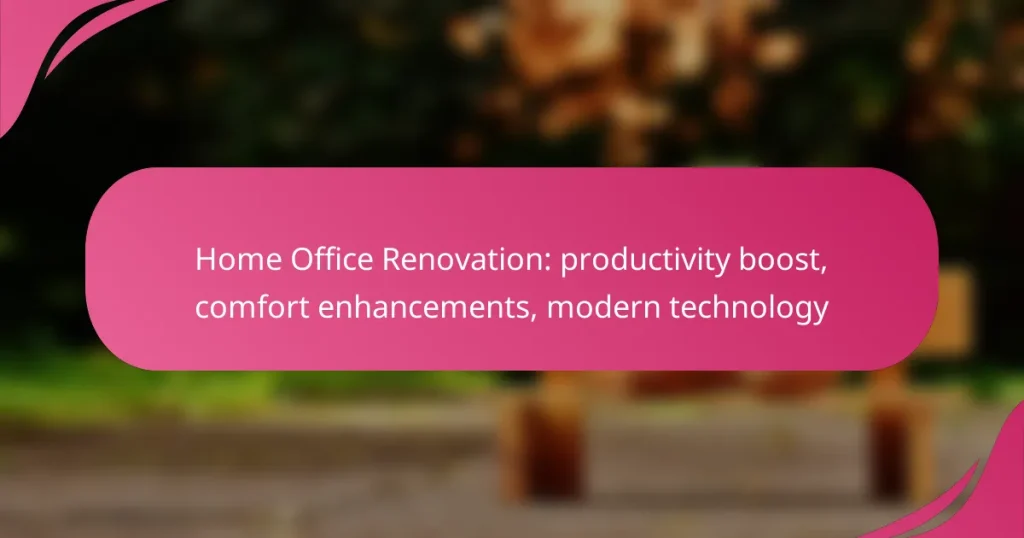A well-executed home office renovation can transform your workspace into a hub of productivity and comfort. By integrating ergonomic furniture, optimized lighting, and modern technology, you can create an environment that minimizes distractions and enhances focus. Additionally, thoughtful design elements and climate control contribute to a more enjoyable and efficient work experience.

How can home office renovation boost productivity in Canada?
A well-planned home office renovation can significantly enhance productivity by creating a comfortable and efficient workspace. This involves incorporating ergonomic furniture, optimized lighting, and soundproofing to minimize distractions and improve focus.
Ergonomic furniture benefits
Investing in ergonomic furniture is essential for maintaining comfort during long working hours. Chairs that support the lower back and desks that allow for proper posture can reduce fatigue and discomfort, leading to increased productivity.
Consider adjustable desks that enable standing or sitting options, as these can help alleviate strain and promote movement throughout the day. Look for chairs with adjustable features to fit your body type and preferences.
Optimized lighting solutions
Proper lighting can greatly influence your work efficiency and mood. Natural light is ideal, so positioning your desk near a window can enhance alertness and reduce eye strain. If natural light is limited, consider using full-spectrum LED bulbs that mimic daylight.
Incorporate task lighting to focus on specific areas without causing glare on screens. Dimmers can also be beneficial, allowing you to adjust the brightness according to the time of day and your activities.
Soundproofing options
Soundproofing your home office can minimize distractions from outside noise, which is crucial for maintaining concentration. Consider adding acoustic panels or soundproof curtains to absorb sound and reduce echo within the room.
Insulating walls and using rugs or carpets can also help dampen noise. If you’re in a noisy area, white noise machines or noise-canceling headphones can provide additional relief from disruptive sounds.

What comfort enhancements are essential for a home office?
Essential comfort enhancements for a home office include effective climate control, personalized workspace design, and the use of quality materials. These elements contribute significantly to productivity and overall well-being while working from home.
Climate control systems
Climate control systems are vital for maintaining a comfortable temperature and air quality in your home office. Options include central heating and cooling, portable air conditioners, or even smart thermostats that adjust based on your preferences.
When selecting a system, consider energy efficiency ratings and the size of your workspace. A well-regulated environment can enhance focus and reduce fatigue, making it easier to work for extended periods.
Personalized workspace design
Personalized workspace design allows you to create an environment that reflects your style and meets your functional needs. This can include ergonomic furniture, adjustable desks, and adequate lighting tailored to your tasks.
Incorporating elements like plants, artwork, or color schemes that inspire you can also boost motivation. Aim for a layout that minimizes distractions and promotes a seamless workflow.
Quality of materials used
The quality of materials used in your home office can greatly impact comfort and durability. Invest in high-quality office furniture, such as chairs that provide proper lumbar support and desks made from sturdy materials.
Additionally, consider soundproofing materials or high-quality flooring options that reduce noise and enhance the overall aesthetic. Choosing durable materials can save money in the long run by reducing the need for frequent replacements.

Which modern technologies improve home office efficiency?
Modern technologies that enhance home office efficiency include smart home integration, high-speed internet solutions, and collaboration tools. These innovations streamline workflows, improve connectivity, and foster better communication, ultimately boosting productivity.
Smart home integration
Smart home integration involves connecting various devices and systems to create a cohesive working environment. This can include smart lighting, thermostats, and voice-activated assistants that help manage tasks and control the office atmosphere.
For example, using smart lighting can adjust brightness based on the time of day, reducing eye strain and improving focus. Consider investing in smart plugs to automate devices, ensuring they operate only when needed, which can save energy and enhance comfort.
High-speed internet solutions
High-speed internet is crucial for maintaining productivity in a home office. Options such as fiber-optic connections or cable internet can provide the necessary bandwidth for video conferencing, large file transfers, and seamless online collaboration.
When choosing an internet plan, look for speeds of at least 100 Mbps for optimal performance, especially if multiple users are online simultaneously. Regularly test your connection speed and consider upgrading your router or using a mesh network to eliminate dead zones in your workspace.
Collaboration tools and software
Collaboration tools and software facilitate communication and project management among remote teams. Platforms like Slack, Microsoft Teams, and Trello allow for real-time messaging, file sharing, and task tracking, making it easier to stay organized and connected.
When selecting collaboration tools, prioritize those that integrate well with your existing systems and offer user-friendly interfaces. Regularly evaluate your team’s needs and be open to adopting new tools that can further enhance productivity and streamline workflows.

What are the costs associated with home office renovations in Canada?
The costs of home office renovations in Canada can vary widely based on factors such as size, materials, and technology upgrades. On average, homeowners might expect to spend anywhere from CAD 5,000 to CAD 20,000, depending on the extent of the changes and the quality of finishes chosen.
Average renovation costs
For a basic home office setup, costs typically range from CAD 5,000 to CAD 10,000. This may include painting, new flooring, and basic furniture. More extensive renovations, which might involve structural changes or high-end technology, can push costs to CAD 15,000 or more.
In addition to labor and materials, consider potential costs for permits if you’re making significant structural changes. Always check local regulations to ensure compliance, as this can affect your overall budget.
Budgeting tips for renovations
Start by defining your renovation goals and prioritize essential upgrades. Create a detailed budget that includes a buffer of about 10-20% for unexpected expenses. This helps avoid financial strain during the renovation process.
Research and compare prices for materials and labor. Consider sourcing materials from local suppliers or looking for sales to save costs. If possible, tackle some tasks yourself, like painting or assembling furniture, to reduce labor expenses.

How to choose the right contractors for home office renovations?
Selecting the right contractors for home office renovations involves assessing their qualifications, experience, and reputation. Prioritize contractors who specialize in home office projects and have a proven track record of successful renovations.
Evaluating contractor experience
When evaluating contractor experience, look for professionals who have completed similar home office renovations. Check how long they have been in business and their familiarity with modern technologies and design trends that enhance productivity and comfort.
Consider asking for a portfolio of past projects. This will give you insight into their style and quality of work. Aim for contractors who have worked on multiple projects within the last few years, as this indicates they are up-to-date with current practices.
Checking references and reviews
Checking references and reviews is crucial in the contractor selection process. Reach out to previous clients to inquire about their experiences, focusing on communication, adherence to timelines, and overall satisfaction with the renovation.
Online reviews can also provide valuable insights. Look for contractors with consistently positive feedback on platforms like Google, Yelp, or local home improvement sites. Pay attention to any recurring issues mentioned in reviews, as they may indicate potential problems.

What are the latest trends in home office design?
Recent trends in home office design focus on enhancing productivity and comfort through modern technology and thoughtful aesthetics. Key elements include sustainable materials, minimalist designs, and smart technology integration to create functional and inviting workspaces.
Sustainable materials usage
Sustainable materials are increasingly popular in home office renovations, emphasizing eco-friendliness and durability. Options like reclaimed wood, bamboo, and recycled metal not only reduce environmental impact but also add unique character to the space.
When selecting materials, consider certifications such as FSC (Forest Stewardship Council) for wood products or LEED (Leadership in Energy and Environmental Design) standards for overall design. These certifications ensure that materials are sourced responsibly and contribute to a healthier indoor environment.
Minimalist design approaches
Minimalist design in home offices promotes simplicity and functionality, reducing distractions and enhancing focus. This approach often features clean lines, neutral color palettes, and a clutter-free environment, making it easier to maintain productivity.
To implement a minimalist design, prioritize essential furniture and technology. Choose a desk with built-in storage to keep supplies organized, and limit decorative items to a few meaningful pieces. This not only creates a serene workspace but also encourages a more efficient workflow.

How can I future-proof my home office renovation?
To future-proof your home office renovation, focus on incorporating flexible design elements, modern technology, and sustainable materials. This approach ensures that your workspace remains functional and comfortable as your needs evolve over time.
Productivity Boost
Enhancing productivity in your home office involves creating an environment that minimizes distractions and maximizes efficiency. Consider using ergonomic furniture, such as adjustable desks and supportive chairs, which can help maintain focus during long work hours.
Incorporate ample natural light and adjustable artificial lighting to reduce eye strain and improve mood. A well-organized workspace with designated areas for different tasks can also streamline your workflow and keep you motivated.
Comfort Enhancements
Comfort in your home office is crucial for maintaining long-term productivity. Invest in high-quality materials for flooring, walls, and furniture to create a pleasant atmosphere. Soft textiles, such as curtains and cushions, can add warmth and reduce noise.
Temperature control is another key factor; consider installing a programmable thermostat or using fans and heaters to maintain a comfortable climate year-round. Personal touches, like plants or artwork, can also enhance your comfort and make the space feel inviting.
Modern Technology
Integrating modern technology into your home office can significantly improve efficiency and connectivity. Start with a reliable high-speed internet connection, as this is essential for video calls and online collaboration.
Consider investing in smart devices, such as voice-activated assistants, smart lighting, and noise-canceling headphones, to streamline your daily tasks. Additionally, ensure that your office is equipped with the latest software and tools relevant to your work, which can enhance productivity and collaboration.


